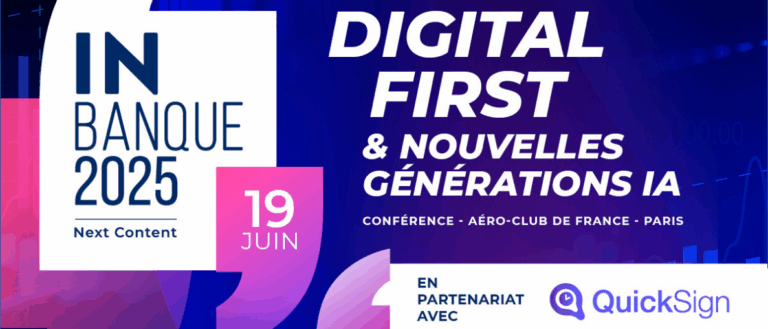
On April 30, 2025, the second edition of Bank Tech Day took place in Paris. The event once again confirmed its role as a key gathering for innovation in banking and financial services. Organized by Finance Innovation, the conference brought together leading figures from finance and tech. The objective: to discuss the major shifts shaping the future of banking.
This year, the conference was hosted at the prestigious Opéra Garnier, a setting as ambitious as the topics covered throughout the day. More than 1,300 participants attended the event, including executives, product leaders, compliance experts, and fintech founders. With three simultaneous stages, a comprehensive exhibition space, and a dense program of talks and discussions, the event offered both strategic insights and operational takeaways.
For the first time, QuickSign took part as an official partner and sponsor. Our teams were on site throughout the day to engage with industry leaders and share our vision for secure, compliant, and scalable onboarding digital in financial services.
QuickSign hosts expert panel: “Are digital banks winning the race?”
As part of the program, QuickSign hosted a panel discussion exploring a central question in the financial services ecosystem:
“Are digital banks winning the race?”
The panel featured industry executives:
- Thibaut Ravisé, CEO & Co-founder, Quicksign
- Pierre Villeroy de Galhau, Head of Strategy & General Secretary, Boursorama
- Jérémie Rosselli, General Manager, N26
Three key takeaways emerged from the session, reflecting the core dynamics of digital banking today.
1. Smaller teams, sharper expertise
Digital banks operate with lean, highly specialized teams. This agile structure allows for faster innovation cycles, smoother adaptation to user needs, and more effective optimization of customer journeys — particularly during the onboarding phase, which is increasingly viewed as a key competitive differentiator.
Balancing conversion, fraud, and compliance
One of the most complex challenges remains finding the right balance between delivering a seamless customer experience and ensuring full compliance with regulatory frameworks. Digital-native institutions address this through data-driven strategies, robust KYC systems, and automation tools that support both risk management and operational efficiency.
Pricing as an entry point, value as a growth driver for digital banks
While competitive pricing remains a key acquisition lever for digital banks, long-term growth depends on more than just cost advantage. Success is built on the ability to earn user trust, deliver high-value services, and scale operations sustainably — all within a secure and compliant framework.
While digital banks have shown strong momentum, they still face important challenges.
First, they must achieve critical mass. Without sufficient volume, their business models risk stalling, especially in markets with thin margins and high compliance costs.
Second, geographic expansion is both an opportunity and a hurdle. Entering new markets means adapting to different regulatory frameworks, user behaviors, and competitive landscapes.Third, and perhaps most importantly, is the need to build strong, credible brands. In financial services, brand trust is a cornerstone. Customers need to feel confident that their bank — whether digital or traditional — is secure, transparent, and here to stay.
This is especially true in a world where reputational risks can spread rapidly. A strong brand is not just a marketing asset; it’s a strategic shield.
QuickSign’s perspective
At QuickSign, we believe that digital banks are not merely keeping pace with traditional players — they are actively redefining what banking should look like in the digital age.
Our mission is to support this transformation by providing a secure, compliant, and scalable digital onboarding solution, built for international growth and aligned with the expectations of today’s most demanding financial institutions.
For a behind-the-scenes look at the event, watch our exclusive Bank Tech Day 2025 vlog.
Written by Isalys L.


